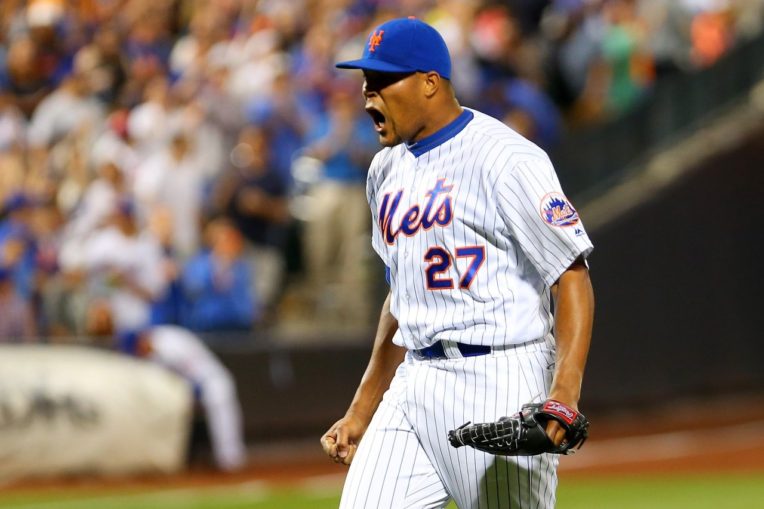
Long winning streaks are fun. The New York Mets have mostly saved their best ones for April in recent years.
Earlier this week, I broke down the crucial June road trip the 2006 Mets that changed the trajectory of their season. It was also the longest winning streak Willie Randolph‘s squad would put together all season.
With that in mind, I was curious about the specifics of New York’s longest winning streaks in recent memory. For the cases of today’s exercise, “recent memory” qualifies as 2015 to 2019. The interesting part here is that while the Mets’ last three winning seasons included noticeable second-half surges, only one included a string of consecutive wins that was their best stretch of the regular season.
Which year was it? You probably already know, but I’ll just keep you in suspense anyways. Below, I’ll share details of the organization’s longest winning streak for each of the last five years. This will include the opponents, locations, dates, and standout performances from both the position players and pitching staff.
2015: 11 games, April 12-23
Opponents (Locations): Atlanta Braves (home and away), Philadelphia Phillies (home), Miami Marlins (home)
Ah, yes, the long winning streak that made April a successful month and eventually enabled Sandy Alderson to pull the trigger on a bunch of deadline deals. The Mets mostly treaded water between May and July before Yoenis Cespedes arrived, but that wouldn’t have happened without a big April thanks to this winning streak.
Lucas Duda was the man that led the position players, with both a 193 wRC+ and 0.6 fWAR. He only slugged one home run during this 11-game span but slashed .366/.458/.585 in 48 plate appearances, driving in seven runs and scoring another seven. Wilmer Flores wasn’t too far behind him, either (189 wRC+ and 0.5 fWAR in 35 plate appearances).
Would it be shocking that Jacob deGrom led the pitching staff? No, and in typical deGrominant style: he won both his starts (spanning 13.1 innings), stranded every runner that reached base and didn’t give up a single run. Bartolo Colon was right behind him in the fWAR department, racking up 20.1 innings and three victories with a 3.15 ERA.

2016: 8 games, April 22-30
Opponents (Locations): Braves (road), Cincinnati Reds (home), San Francisco Giants (home)
Before this streak started, the Mets were muddling through a mediocre start to defending their NL pennant. This eight-game run gave them a second consecutive dominant April. Of course, it took a ridiculous last five weeks just to reach the NL Wild Card play-in game.
Steven Matz and Noah Syndergaard both finished at the top of the pitching staff fWAR leaderboard with 0.4 fWAR each. Even though it’s more impressive that Thor did so in half the number of innings pitched, we’ll give the nod to Matz here. He won both his starts, which spanned 12.1 frames and resulted in a 1.46 ERA, a 22.2% strikeout rate, and a 5.6% walk rate.
The 2016 season was full of growing pains for Michael Conforto, but not during this winning streak. He tore the cover off the ball to the tune of a .484/.514/.871 line with two home runs, 10 RBI, and eight runs scored in 35 plate appearances. That was good for a 264 wRC+ and 0.9 fWAR. To put this in perspective, Conforto finished the season with his overall performance being worth just 1.0 fWAR in 348 plate appearances.
2017: 5 games, April 9-13
Opponents (Locations): Marlins (home and away), Phillies (away)
Based off the prior two years, we hoped this short (comparatively speaking) winning streak was just the beginning of another competitive year. Not even a little bit. The closest they got to a winning month in Terry Collins‘ last year as manager was May, where they went 14-14. August put the nail in the coffin with a 10-20 performance.
Cespedes did what he normally does on the field when he’s been healthy in Queens: mash. Through this short period, he accumulated 0.6 fWAR off the strength of a 276 wRC+. Yo paired five homers, nine RBI, and six runs scored to his .364/.423/1.136 line, which he did in 26 plate appearances.
This win streak only allowed for one full turn around the rotation, and Syndergaard had the best start of all. He accumulated 0.4 of his 1.4 fWAR to start the streak on April 9th before essentially being lost for the year with a torn lat muscle. He tossed seven innings against Miami, allowing two runs (one earned) on five hits, no walks, and nine strikeouts. His 75 game score was the highest he produced in a shortened campaign.

2018: 9 games, April 3-13
Opponents (Locations): Phillies (home), Washington Nationals (away), Marlins (away), Milwaukee Brewers (home)
Remember when we thought Mickey Callaway was a managerial genius? That was a long time ago. Any hopes of competing following a 17-9 start to the season was dismantled in the two months that followed thanks to a 15-39 mark. For a little while in April, though, it felt like the Mets could’ve been on the verge of something special.
The man who led the pitching staff during this streak? It was actually Jeurys Familia. He collected 6.2 innings in six appearances (all of which were converted save opportunities). He didn’t give up a single run, generated ground balls at a 66.7% clip and paired it all with a 33.3% strikeout rate and 4.2% walk rate. Just in case you were wondering, deGrom’s first Cy Young campaign started off “slow” by his terms, with one win in two starts (12 innings) and a 3.75 ERA.
Todd Frazier and Asdrubal Cabrera tied at the top of the fWAR leaderboard for position players with 0.6 fWAR. Cabby gets the nod, though, thanks to a slight edge in wRC+ (195 to 187). In 39 plate appearances, Cabrera slashed .361/.410/.667 with three homers, four RBI, and 10 runs scored.
2019: 8 games, August 3-10
Opponents (Locations): Pittsburgh Pirates (away), Marlins (home), Nationals (home)
Finally, a long winning streak that took place outside the month of April! This made the final stretch of the regular season the most interesting it had been since 2016. Although the Mets ultimately fell short of a wild-card berth, it at least has us excited about what’s possible in the near future. You know, if baseball is ever played again.
The offense was poppin’ for this streak, as there were four players (J.D. Davis, Wilson Ramos, Jeff McNeil, and Conforto) who had at least 25 plate appearances and a wRC+ above 200. Conforto and McNeil were tied at the top with 0.7 fWAR, but Scooter had the edge in wRC+ (267 to 246). He slashed .391/.517/.957 with four homers, eight RBI, and seven runs scored. It was also eye-popping to see a 13.8% walk rate and 3.4% strikeout rate from him during this time.
Zack Wheeler and Syndergaard both tied with 0.3 fWAR, although Wheeler did it in nearly half as many innings (eight) as his former teammate (14). Wheeler’s start was right in the middle of New York’s win streak, facing the Marlins on August 6th. He scattered eight hits and one walk while striking out five and keeping Miami off the board. From a game-score perspective, this was his fourth-best start of the entire year.
















